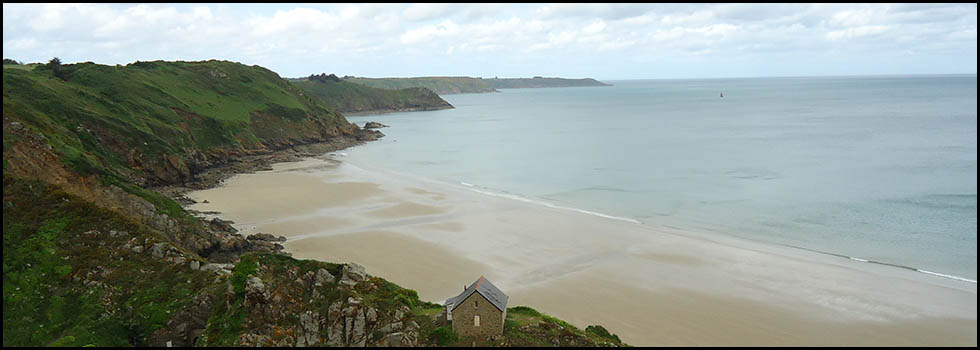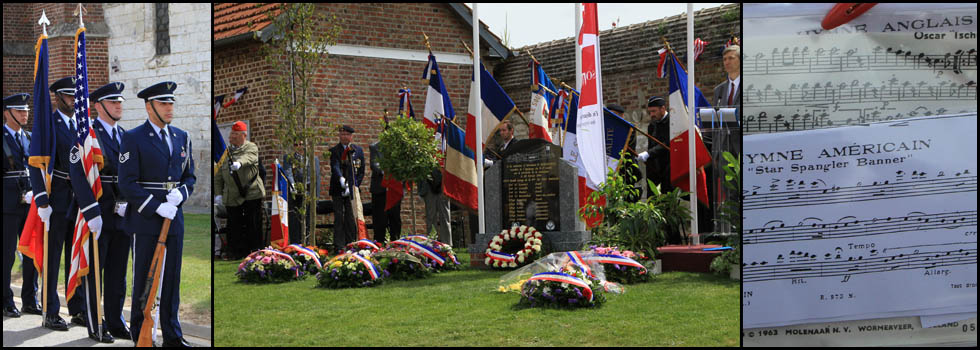4th August 1944
Victoria Cross, Distinguished Flying Cross
Avro Lancaster MkIII ND811
F2-T
RAF 635 Squadron
Senantes (Oise)
Ian Willoughby Bazalgette was born on 19th October 1918 in Calgary, Canada, from Anglo-Irish parents, third child of a family running a farm.
His father, who had been wounded and gassed in the First World War, still suffered the after-effects. Having difficulty in administering his farm, he finally gave up his job.
During his youth, he developed a passion for writing music, reading and photography.
In July 1939, a few months before the outbreak of the Second World War, Ian W. Bazalgette enlisted in the Royal Artillery and found himself assigned in Scotland, to the 51st Highland Searchlight Regiment which was equipped with radar controlled searchlights.
From 1940, the Battle of Britain began. The Luftwaffe of Marshal Goering first attempted to destroy the British convoys in the English Channel and then took on in vain the Royal Air Force before starting the “Blitz”, the bombing of London and other large British cities.
In 1941, wanting to become more involved in the war, Ian W. Bazalgette got his transfer to the Royal Air Force which was in need of pilots. In June, he went back to England, to the n° 22 Elementary Flying Training School in Cambridge. After ten hours of dual instruction, he took his first solo flight in a Tiger Moth on 3rd August 1940.
 Over the months, Ian W. Bazalgette passed successively through various flying schools of the RAF, learning to fly twin-engined planes.
Over the months, Ian W. Bazalgette passed successively through various flying schools of the RAF, learning to fly twin-engined planes.
On 30th September 1942, piloting a twin-engined Vickers Wellington with crew, Pilot Officer Bazalgette flew his first mission over Holland.
From that time until the end of 1942, night missions over enemy territory became almost routine for P/O Bazalgette and the crews of 115 Squadron. Meanwhile, in November, he was promoted to Flying Officer.
In February 1943 a new aircraft, the four-engined Lancaster, began to replace the Wellingtons of 115 Squadron, requiring pilots and crews to be converted.
His first mission aboard this new aircraft comprising a crew of seven men was on the night of 22nd to 23rd March 1943. It was the bombing of Saint Nazaire harbour but the aircraft were recalled beafore reaching the target.
Throughout 1943, raids in which F/O Bazalgette took part, intensified over the Ruhr and German cities such as Berlin, Essen, Duisburg, Dortmund ... heavily defended cities, always entailing a high rate of losses among the Allied aircraft.
Promoted to Squadron-Leader and having completed his first tour of operation, Ian W. Bazalgette was awarded the Distinguished Flying Cross on 1st July 1943.
At the end of 1943, now an experienced pilot, he was sent as an instructor to Scotland before, after a few weeks of training, getting his transfer to the Pathfinder Force.
The missions started again, still extremely dangerous, over cities and strategic enemy sites, until the fateful day of 4th August 1944.
That day, in the morning, S/L Bazalgette and his crew took off from the Downham Market airbase at about 11:15 am aboard the Lancaster ND811 "F2-T." This was his 58th operational mission, being close to completing his second tour of operations.
The crew :
| S/L Ian W. BAZALGETTE | RAF | Pilot | KIA |
| Sgt. George R. TURNER | RAF | Flight engineer | Evaded |
| F/L Geoffrey R. GODDARD | RAF | Navigator | Evaded |
| F/L Ivan A. HIBBERT | RAF | Bomb aimer | KIA |
| F/O Charles R. GODFREY | RAF | Wireless operator | Evaded |
| F/S Vernon V. R. LEEDER* | RAAF | Mid upper gunner | KIA |
| F/O Douglas CAMERON | RAF | Rear gunner | Evaded |
*F/S Vernon Leeder, of the Royal Australian Air Force, was not part of the usual crew of S/L Bazalgette. He replaced F/S Hurnhall on that day.

Ten Lancasters of 635 Squadron of the Pathfinder Force were assigned to "mark" the target for the main force of 61 other Lancasters of the Royal Air Force. The target : the bombing of the V-1 rockets storage sites in Trossy - Saint-Maximin (Oise).
Since mid-June, these flying bombs hit the agglomeration of London and England. It was therefore extremely important for Bomber Command to annihilate this site permanently. Shelled heavily during night raids since July and heavily protected by antiaircraft defences and the German night fighters, the Royal Air Force had already lost a number of bombers.
This new mission was thus considered to be high-risk and most dangerous for the crews.
Approaching the target, while the formations flew straight, Flak was unleashed. Two aircraft preceding the Lancaster of S/L Bazalgette were hit by gunfire from the ground. One, piloted by F/L Robert W. Beveridge, dived in flames and crashed near the village of Saint-Maximin. All the crew perished.
It was S/L Ian W. Bazalgette that now took responsibility for marking the target, but in turn, his aircraft was hit by flak. Both engines and fuel tanks of the starboard wing caught fire. Flames licked the fuselage. Managing to keep the aircraft in the line of flight, Squadron Leader Bazalgette accurately dropped markers and bombs on the target, allowing the other Lancasters to bomb the site with precision.
Lightened of its load but destabilized, the four-engined aircraft went into a spin, rapidly losing altitude, rekindling the fire that devoured the starboard wing. The cool head and control of S/L Bazalgette allowed him to regain control of the aircraft.
Bursts of flak hit the front part of the Lancaster, badly injuring F/L Hibbert. His right arm half torn off, he was relieved of his position in a critical condition by Turner and Godfrey who took him towards the rear of the aircraft. Lying on a stretcher, he was injected with morphine.
On board, the crew fought the flames. Smoke and gas spread inside the aircraft, causing the asphyxia of F/S Leeder.
Flying to North-West, it was clear that the Lancaster could not make it back to England.
Having lost altitude, it was the turn of one of the engines on the port wing to stop.
In agreement with Flight Engineer Turner, S/L Bazalgette ordered the crew to evacuate. It was early afternoon. In the vicinity of the village of Senantes, in Oise, Cameron, Turner, Goddard and Godfrey abandoned the aircraft in turn from an altitude of 300 ft.
Aware that F/L Hibbert and F/S Leeder were unable to parachute, S/L Bazalgette refused to abandon them.
After avoiding the village of Senantes by making a wide turn, he decided to try landing the stricken Lancaster in a field. At about one kilometer from the village, the aircraft landed perfectly .... but exploded a few seconds later. The three airmen were killed.
Mr Simeon Desloges, a young child in 1944, remembers watching the burning aircraft avoid the village at low level. Then a large explosion was heard followed by a large cloud of smoke rising into the sky.
In the afternoon, the bodies of Flight Lieutenant Hibbert and Flight Sergeant Leeder were extracted from the wreckage of the aircraft. Taken to the church of Senantes, it was decided that they would be buried with dignity in the village cemetery on the following Sunday.
But in the morning of this Sunday 6th August, while the population was preparing to pay tribute to the two airmen, the Germans took their bodies and buried them in the Beauvais-Marissel military cemetery.
The funeral having therefore not taken place, everyone went to the crash site, despite the fear of the arrival of the arrival of the Germans, and laid countless flowers as a sign of gratitude among the debris of the Lancaster.

The four surviving airmen, gathered around, soon reported to their rescuers, despite the language barrier, that they were seven on board the aircraft and the pilot's body was definitely still in the wreckage. Discreetly, searching started again. The remains of S/L Bazalgette were found in the debris.
The pilot's body was kept until the burial ceremony. It took place in Senantes on Sunday 8th October 1944 in the presence of his sister Ethel, British and French military authorities and a large crowd who came to pay tribute to the airman.
In 1945, S/L Ian W. Bazalgette was posthumously awarded the Victoria Cross, Britain's highest military award, for his heroic sacrifice in not wanting to abandon his two wounded comrades who had remained on board.
The four survivors escaped German searching and arrest.
Charles Godfrey and Geoffrey Goddard landed close to each other near the village of Senantes. In the evening, they were hidden at the house of the schoolteacher of the village, Mr. Laluet, where they were provided with civilian clothes. Notified Henri Maigret came to interrogate them and took pictures which could be used for their false identity papers.
The next day, now taken in charge by the "Alsace" escape network, Henri Maigret took them in a cart to the Desserre family, managers of the farm of La Boissiere in Blacourt, where they stayed until 20th August, namely for a period of twelve days.
For safety reasons, it was decided to move the two airmen. In a cart, Henri Maigret took over their transfer, in the middle of retreating German troops, to La Neuville-sur-Auneuil in Pierre Muller‘s farm.
The arrival of Allied troops was imminent, the Liberation approaching. Farms in the region were full of airmen. Many of them were hidden in the vicinity and lodging opportunities were becoming few and far between.
It was therefore decided to create a temporary camp and to gather together the airmen in a thick wood in Le Saussay, located near the village of Porcheux.
Pierre Muller took Charles Godfrey and Geoffrey Goddard to this camp on the evening of their arrival.
A British armoured column freed them on 30th August.
George Turner landed near the hamlet of Bois-Aubert, a few hundred metres from Senantes. Injured in his back, he was collected and lodged by René Cocu, a farmer in the hamlet of Groscourt, where he was to await the Liberation.
After landing near Glatigny and having narrowly escaped the Germans, Douglas Cameron was hosted by the Anse family in Glatigny and the Roisse family in Hanvoile. He chose to participate with the local Resistance in different acts of sabotage against the enemy until the Liberation.
Charles Godfrey and George Turner came back several times after the war to thank their rescuers. They were also present on 4th August 1994, accompanied by the daughter of Douglas Cameron, for the dedication ceremony of the memorial erected on the crash site in memory of their comrades who were killed fifty years earlier.
On 27th July 1990, in the Bomber Command Museum of Canada in Nanton, South of Calgary, Alberta, a ceremony took place in memory of Squadron Leader Ian Willoughby Bazalgette. On this occasion, his sister Ethel, George Turner and Charles Godfrey unveiled a plaque in honour of the pilot and a Lancaster, with the same markings that he was flying during the tragic mission of 4th August 1944, became the Ian Bazalgette Memorial Lancaster.
On 15th August 2009, at the Museum of Nanton, was signed by their respective mayors, the act of twinning the village of Senantes and the Canadian city in memory of the courage and sacrifice of S/L Bazalgette.
On 27th June 2014, a ceremony was held at Senantes.
"Baz", the biography of Ian W. Bazalgette VC, written by Dave Birrell.





